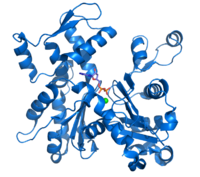
Photo from wikipedia
The integrity and functions of epithelial barriers depend on the formation of adherens junctions (AJs) and tight junctions (TJs). A characteristic feature of AJs and TJs is their association with… Click to show full abstract
The integrity and functions of epithelial barriers depend on the formation of adherens junctions (AJs) and tight junctions (TJs). A characteristic feature of AJs and TJs is their association with the cortical cytoskeleton composed of actin filaments and nonmuscle myosin II (NM‐II) motors. Mechanical forces generated by the actomyosin cytoskeleton are essential for junctional assembly, stability, and remodeling. Epithelial cells express two different actin proteins and three NM‐II isoforms, all known to be associated with AJs and TJs. Despite their structural similarity, different actin and NM‐II isoforms have distinct biochemical properties, cellular distribution, and functions. The diversity of epithelial actins and myosin motors could be essential for the regulation of different steps of junctional formation, maturation, and disassembly. This review focuses on the roles of actin and NM‐II isoforms in controlling the integrity and barrier properties of various epithelia. We discuss the effects of the depletion of individual actin isoforms and NM‐II motors on the assembly and barrier function of AJs and TJs in model epithelial monolayers in vitro. We also describe the functional consequences of either total or tissue‐specific gene knockout of different actins and NM‐II motors, with a focus on the development and integrity of different epithelia in vivo.
Journal Title: Annals of the New York Academy of Sciences
Year Published: 2022
Link to full text (if available)
Share on Social Media: Sign Up to like & get
recommendations!